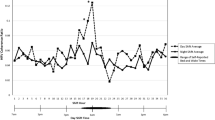Summary
Heart rate was recorded at regular intervals during the course of 8-h sessions of simulated sedentary shift work performed for 12 consecutive days. Separate groups of subjects were assigned to one of three shifts, commencing either at 0400 hours (“morning” shift), 0800 hours (“day” shift) or 2200 hours (“night” shift). A major meal was taken during a break in the middle of each shift. In all groups heart rate fell during the pre-break period, but rose after the break in response to the meal. This pattern remained constant over the 12-day period in the morning and day shift groups, but in the night shift group a progressive rise in the general level of the readings, caused mainly by the adjustment of the circadian rhythm to the altered sleeep/wake cycle, was accompanied by systematic changes in the extent of both the pre-break fall and the post-meal rise. Comparison with the results of a control study of 24-h variation in base heart rate suggested that differential responses to the meal observed in the three shift groups may have been due, at least in part, to differences in their personality make-up. It is concluded that, although systematic patterns of heart rate can be observed in sedentary shift work, both the timing of the shift and the personality of the subject must be taken into account when assessing the changes in physiological state likely to occur during work sessions that include a major break for refreshment.
Similar content being viewed by others
References
Blake MJF (1967) Relationship between circadian rhythm of body temperature and introversion-extraversion. Nature 215:896–8971
Christie MJ, McBrearty EM (1979) Psychophysiological investigations of post lunch state in male and femal subjects. Ergonomics 22:307–323
Colquhoun WP, Folkard S (1978) Personality differences in body-temperature rhythm and their relation to its adjustment to night work. Ergonomics 21:811–817
Colquhoun WP, Blake MJF, Edwards RS (1968) Experimental studies of shiftwork. II. Stabilized 8-hour shift systems. Ergonomics 11:527–546
Craig A, Baer K, Diekmann A (1981) The effects of lunch on sensory-perceptual functioning in man. Int Arch Occup Environ Health 49:105–114
Heron A (1956) A two-part personality measure for use as a research criterion. Br J Psychol 47:243–251
Knauth P (1983) Ergonomische Beiträage zu Sicherheitsaspekten der Arbeitszeit-organisation. VDI-Verlag GmbH, Düssel-dorf
Rutenfranz J, Klimmmer F, Knauth P (1975) Desynchronization of different physiological functions during three weeks of experimental nightshift with limited and unlimited sleep. In: Colquhoun P, Folkard S, Knauth P, Rutenfranz J (eds) Experimental studies of shiftwork. Forschungsberichte des Landes Nordrhein-Westfalen, no. 2513. Westdeutscher Verlag, Opladen
Smolensky MH, Tatar SE, Bergman SA, Losman JG, Barnard CN, Dasco CC, Kraft IA (1976) Circadian rhythmic aspects of human cardiovascular function: a review by chronobiologic statistical methods. Chronobiologia 3:337–371
Author information
Authors and Affiliations
Additional information
Dedicated to Professor J. Rutenfranz on the occasion of his 60th birthday
Rights and permissions
About this article
Cite this article
Colquhoun, W.P. Heart rate patterns in sedentary shift work: influence of circadian rhythm, meals and personality. Int. Arch Occup Environ Heath 60, 273–278 (1988). https://doi.org/10.1007/BF00378473
Received:
Accepted:
Issue Date:
DOI: https://doi.org/10.1007/BF00378473




